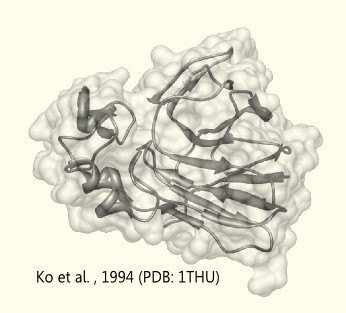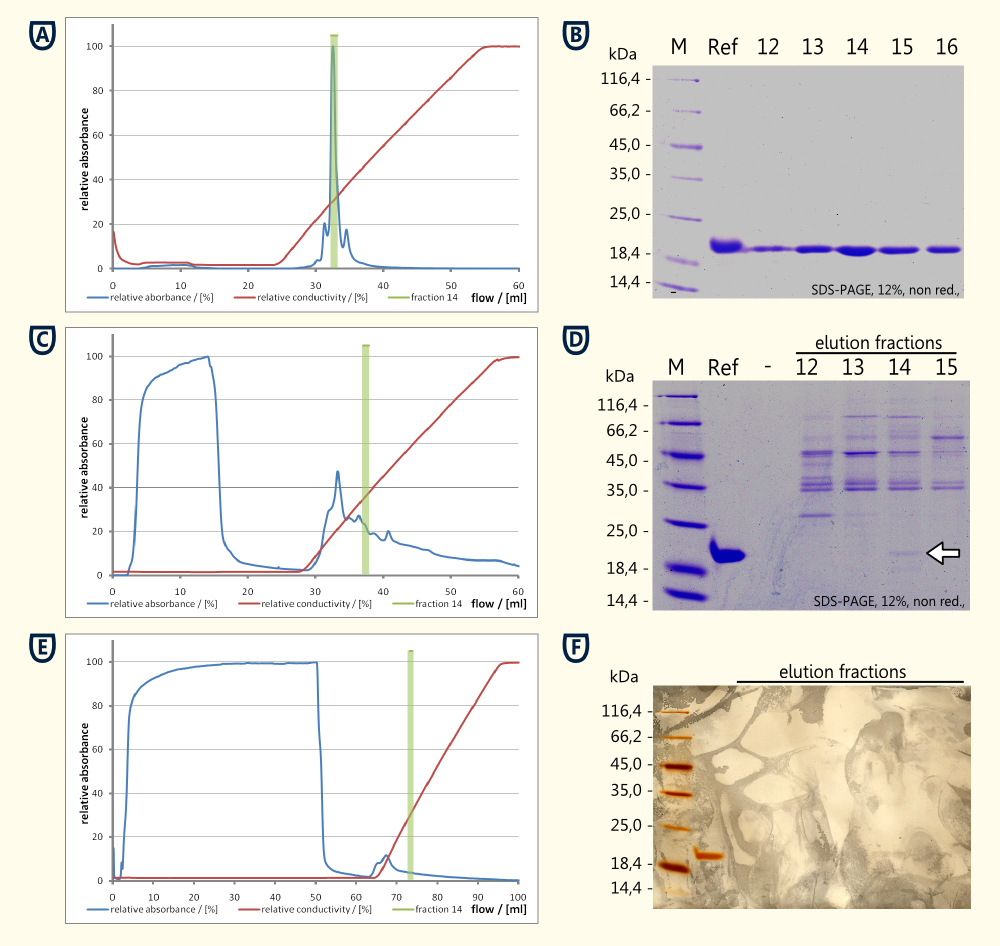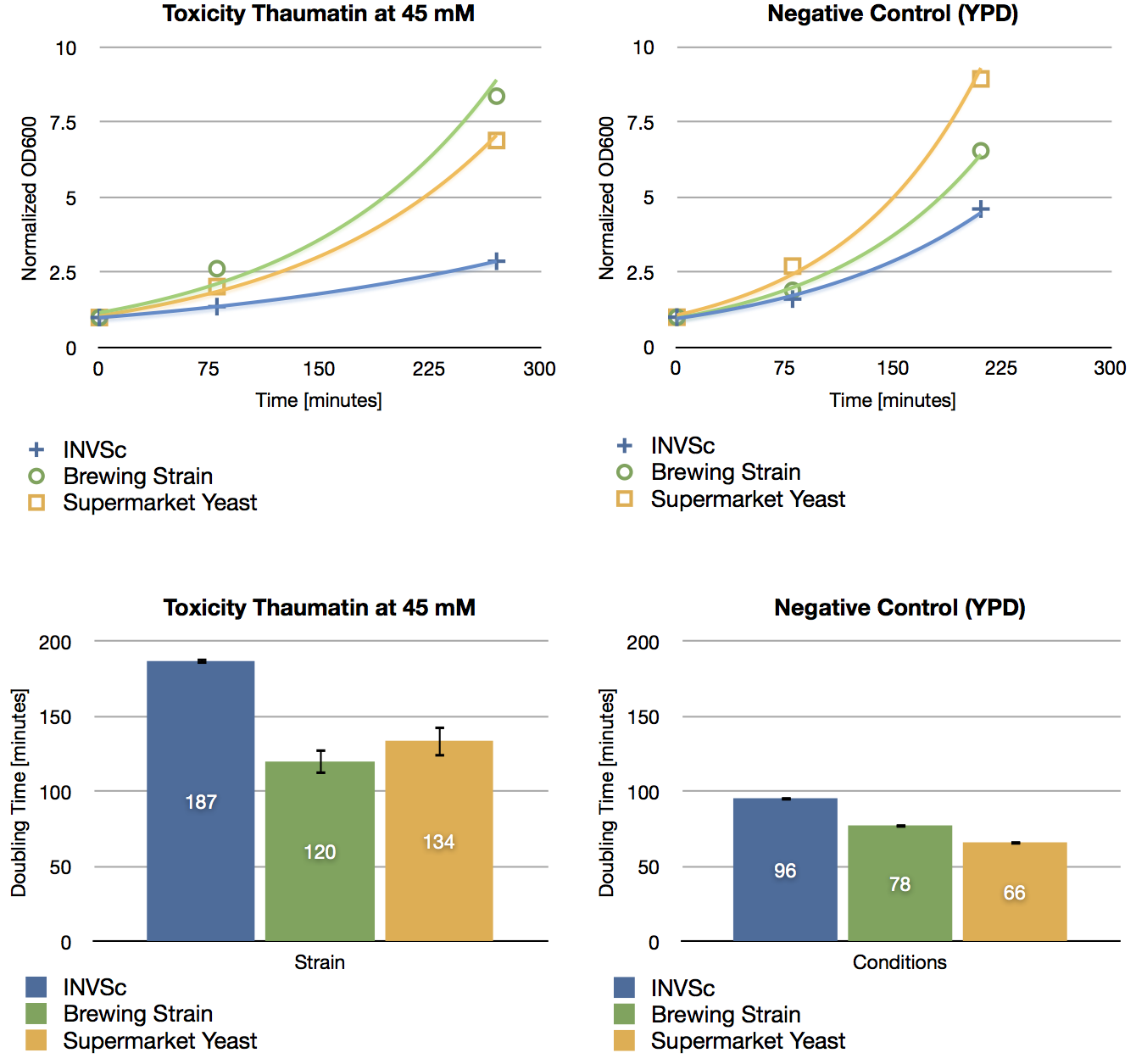Team:TU Munich/Project/Thaumatin
From 2012.igem.org



Contents |
Thaumatin
We must admit, even we don't think that a "Münchner Hell" or a "Pils" would benefit from the distinct sweetness of Thaumatin, originally produced by Thaumacoccus daniellii.
So, why, o why have we chosen Thaumatin? There are a variety of arguments that have to be taken into consideration:
- Since experiments in the 1980ies, nobody tried to express Thaumatin via S. cerevisiae - so we saw the possibility to enhance the production and make it more efficient (as one of the biggest problems for industrial use of Thaumatin so far is the low yield efficiency) by codon usage optimization.
- If you think of the beers of the Anglo-Saxon world - stouts, ales - these are the sorts that could directly profit from the licorice-like sweetness, as they are generally more full-bodied and show a variety of caramel flavors.
- It opens the world of brewage to a whole new generation of lifestyle drinks - perhaps a bit too innovative for the conservative german beer market, but nevertheless there's quite a potential there for cutting-edge beverages with the soul of beer and the savor of all the fruits you can imagine. Thaumatin might serve as a low-carb ingredient to balance out the bitter and sour flavors of guava, grapefruits, currant - or even horseradish.
Background and principles
Thaumatin is a natural α+β-protein which is synthesized by the katamfe plant (Thaumatococcus daniellii) – a species of tropical flowering plants - and belongs to the thaumatin-like protein family. There exist different varieties of thaumatin, however, thaumatin I und thaumatin II are well characterized and differ only in one position (position 46 – without signaling sequence; thaumatin I Asn; thaumatin II Lys). Both are said to be 2000 to 100000 times sweeter than sucrose on molar basis, but the sweetness builds slow and lasts long.
Thaumatin is a single chain with 207 amino acids residues and eight disulfide bonds and a molecular weight of 22.2 kDa. It is highly water soluble, stable at heating (not for cooking, bakery, etc.) and stable under acidic conditions. The production of thaumatin is induced by an attack upon the plant by viroid pathogens. Thus it is involved in systematically acquired resistance and stress response.
Thaumatin has been approved as a sweetener in the European Union (E957).
The molecular and physiological effects of thaumatin
The sweet taste receptor is a heterodimeric receptor composed of T1R2 (also TAS1R2) and T1R3 (also TAS1R3) subunits. The large amino-terminal domains (NTD) of the T1R2 and T1R3 subunits have shown to be responsible for the primary ligand binding http://www.ncbi.nlm.nih.gov/pubmed?term=22450161 Maîtrepierre et al., 2012. In addition these receptors have a transmembrane heptahelical domain. T1R receptors belong to the family of class C G-Protein coupled receptors (GPCRs), which in this case means that through ligand binding an elevation of the cAMP concentration in the taste buds is induced [[http://www.ncbi.nlm.nih.gov/pubmed?term=19489607 Ide et al., 2009], [http://www.ncbi.nlm.nih.gov/pubmed?term=15087236 Ozeck et al., 2004]]. As a result a decrease in the intracellular cAMP accumulation is measured. Released calcium (Ca2+) seems to be another independent second messenger within the transduction of the taste response (downstream of taste receptors) http://www.ncbi.nlm.nih.gov/pubmed?term=16510847 Trubey et al., 2006.
However, not only sucralose or other sugars can bind with the NTDs of the sweet taste receptor, but also thaumatin http://www.ncbi.nlm.nih.gov/pubmed?term=19489607 Ide et al., 2009. It seems to have a longer lasting and stronger effect than sucralose.
Theoretical consideration: How much thaumatin is needed in foodstuff?
Results
BioBricks planing
The BioBricks designed encode the Prepro-Thaumatin ([http://partsregistry.org/wiki/index.php?title=Part:BBa_K801080 BBa_K801080]) that is believed to be exported on it's own (??? please insert reference!!!). The original gene sequence was optimized for best yeast codon usage using GeneArt® GeneOptimizer®. We ordered the gene synthesis and cloned this BioBrick into pSB1C3 and our galactose inducible Yeast expression vector pTUM100. Further more we constructed a expression cassette with xx promoter and the xx terminator, which is also availible as a protein generator (BBa_). This expression casset was subsequently cloned into the integration vector (BBa_ ) to maintain expression in the brewing media that does not maintain the selection pressure for transiently transfected plasmids.
Expression of Thaumatin
The BioBrick for Thaumatin in our yeast vector pTUM100 was expressed in YPD media in a 2l scale and the cells were harvested and disrupted using glass beads. On the SDS-Page showing the cell lysate there was no additional band at the size of Thaumatin.
Ion exchange chromatography
Preprothaumatin becomes posttranslationally modified by cleaving a part of the N- and the C-terminal polypeptide. Therefore it was not possible to add a tag for affinity chromatography. For this reason it was necessary to purify the protein from the cytoplasm of the desintegrated yeast cells using ion exchange chromatography to have a proove of principle.
Experimental details:
- Samples: cell lysate, supernatant from culture, reference for thaumatin (MedHerbs)
- Dialysis against 20mM MES Buffer pH 6.0 (twice) using a 12-16 kDa dialysis membrane
- Chromatography with a Äkta purifier equipped with a Ressource S 6ml (S: Methyl sulfonate (strong cation exchanger))
- Sample was applied using a super-loop
- Wash with two colum volumes 20mM MES Buffer pH 6.0
- Elution with a gradient of 0 - 500 mM NaCl over 5 column volumes
- Fractions of 1 ml were collected during the elution
Experimental results:
- Reference Thaumatin (see figure A and B)
- nealy no protein in the flow through during sample application (see figure A)
- a major peak eluting at ~14 mS*cm-1 which corresponds to fraction Nr. 14 see figure A)
- The corresponding SDS-PAGE showed a clear band around fraction Nr. 14 corresponding matching the expected 22 kDa
- Cell lysate
- high concentration of protein in the flow through (see figure C and D)
- no clear peak arround fraction 14 could be detected
- The SDS-PAGE performed from the reference and the fractions 12 to 15 showed a weak band at the height of the reference. This band having the same size as the reference (see running propperties on SDS-PAGE in figure D) and the same isoelectric point (both eluted in fraction 14) is very likely to be thaumatin which was produced by the yeast cells.
- Supernatant of yeast culture (see figure E and F)
- Export of the protein in high concentrations was unlikely to happen, therefore 48 ml of supernatant were loaded on the column
- Ratio between frowthrough and eluted protein was less favourable compared to the cell lysate.
- Total protein quantities were to low to be detected by Coomassie stain, therefore a silver stain was performed (see figure F)
- Beside the reference no additional proteinbands could be detected on the silver stained SDS-PAGE
Conclusion from this experiment:
A proof of principle for the expression of Thaumatin was achieved using ion exchange chromotography and comparison of bands optained on an SDS-PAGE relative to a standard of Thaumatin.
Further goals would include to increase the expression of the thaumatin and to investigate the secretion. This could be achieved by improving the purification protocol in order to load more than 10 ml of cell lysate on the column in order to purify sufficient protein for a mass spectrum of the produced thaumatin. Another aspect that should be investigated is the transport process that could be monitored in an ELISA or via quantitative western blotting using a polyclonal serum against thaumatin.
Protein in cell lysis
Mass Spectrometry data
Toxicity Assay
Die Grafik ist falsch! Ist bestimmt nicht 1M. Wir hatten abgesprochen 1mg/ml anzusetzen. Außerdem müsste man hier noch die Daten von der Hefe ohne Protein als Negativkontrolle zeigen. ich habe auch 1 mg/ml angesetzt - ich kümmer mich darum (Mary). - die richtige Graphik + Negativkontrolle kommt noch!
To check if thaumatin has an effect on yeast cells , we inoculated three different yeast strains with YPD including 45 mM of thaumatin and measured their growth rate after a defined period of time. The used yeast strains were the laboratory strain INVSc1, a strain which is used for brewing beer and a strain which can be purchased in a supermarket. The growth rate of yeast cells which were incubated with thaumatin does not show a difference compared to the negative control (incubation with YPD without thaumatin). The small differences in doubling time are errors in measurement.
As expected, thaumatin does not have an effect on the growth rate of yeast cells. Hence we are not limited in over-expressing the sweetener in our beer.
References
- http://www.ncbi.nlm.nih.gov/pubmed/17897626 Ide et al., 2007 Ide, N., Masuda, T., and Kitabatake, N. (2007). Effects of pre- and pro-sequence of thaumatin on the secretion by Pichia pastoris. Biochem Biophys Res Commun, 363(3):708–14.
- http://www.ncbi.nlm.nih.gov/pubmed/19489607 Ide et al., 2009 Ide, N., Sato, E., Ohta, K., Masuda, T., and Kitabatake, N. (2009). Interactions of the sweet-tasting proteins thaumatin and lysozyme with the human sweet-taste receptor. J Agric Food Chem, 57(13):5884–90.
- http://www.ncbi.nlm.nih.gov/pubmed/3167035Lee et al., 1988 Lee, J. H., Weickmann, J. L., Koduri, R. K., Ghosh-Dastidar, P., Saito, K., Blair, L. C., Date, T., Lai, J. S., Hollenberg, S. M., and Kendall, R. L. (1988). Expression of synthetic thaumatin genes in yeast. Biochemistry, 27(14):5101–7.
- http://www.ncbi.nlm.nih.gov/pubmed/22450161 Maîtrepierre et al., 2012 Maîtrepierre, E., Sigoillot, M., Le Pessot, L., and Briand, L. (2012). Recombinant expression, in vitro refolding, and biophysical characterization of the n-terminal domain of t1r3 taste receptor. Protein Expr Purif, 83(1):75–83.
- http://www.ncbi.nlm.nih.gov/pubmed/21636903 Masuda et al., 2011 Masuda, T., Ohta, K., Mikami, B., and Kitabatake, N. (2011). High-resolution structure of the recombinant sweet-tasting protein thaumatin i. Acta Crystallogr Sect F Struct Biol Cryst Commun, 67(Pt 6):652–8.
- http://www.ncbi.nlm.nih.gov/pubmed/14991654 Masuda et al., 2004 Masuda, T., Tamaki, S., Kaneko, R., Wada, R., Fujita, Y., Mehta, A., and Kitabatake, N. (2004). Cloning, expression and characterization of recombinant sweet-protein thaumatin ii using the methylotrophic yeast pichia pastoris. Biotechnol Bioeng, 85(7):761–9.
- http://www.ncbi.nlm.nih.gov/pubmed/10049878 Moralejo et al., 1999 Moralejo, F. J., Cardoza, R. E., Gutierrez, S., and Martin, J. F. (1999). Thaumatin production in aspergillus awamori by use of expression cassettes with strong fungal promoters and high gene dosage. Appl Environ Microbiol, 65(3):1168–74.
- http://www.ncbi.nlm.nih.gov/pubmed/15087236 Ozeck et al., 2004 Ozeck, M., Brust, P., Xu, H., and Servant, G. (2004). Receptors for bitter, sweet and umami taste couple to inhibitory g protein signaling pathways. Eur J Pharmacol, 489(3):139–49.
- http://www.ncbi.nlm.nih.gov/pubmed/16510847 Trubey et al., 2006 Trubey, K. R., Culpepper, S., Maruyama, Y., Kinnamon, S. C., and Chaudhari, N. (2006). Tastants evoke camp signal in taste buds that is independent of calcium signaling. Am J Physiol Cell Physiol, 291(2):C237–44.
Others
- Thaumatococcus daniellii mRNA forpreprothaumatin I, comeplete cds http://www.ncbi.nlm.nih.gov/nuccore/121945717?report=genbank
- Preprothaumatin I [Thaumatococcus daniellii], FASTA http://www.ncbi.nlm.nih.gov/protein/121945718?report=fasta
- yeastgenome.org http://www.yeastgenome.org/
older blocks
- please integrate the informations into the other blocks
Idea
The general idea is to create via genetic engineering of Saccharomyces cerevisiae a system that expresses thaumatin, respectively the direct precursor (preprothaumatin). The N-terminal "pre" part is the internal signalling sequence for secretion, the C-terminal "pro" sequence supports the correct and functional folding of thaumatin. Alternatively one could have used a fusion product of prothaumatin and the Mat-α-factor to achieve secretion.
Preferable seems to be the natural preprothaumatin, because of the expected higher yield http://www.ncbi.nlm.nih.gov/pubmed?term=21636903 Masuda et al., 2011 and the possibility that the pre-sequence is necessary for the correct procession http://www.ncbi.nlm.nih.gov/pubmed?term=17897626 Ide et al., 2007. A similar construct was used by the Kyoto University (Ide et al., submitted) in Pichia pastoris with a the pPIC6α expression vector with a high yield (especially with the preprothaumatin I gene and without the α-factor secretion signal).
 "
"



